The Intel Broadwell Desktop Review: Core i7-5775C and Core i5-5675C Tested (Part 1)
by Ian Cutress on June 2, 2015 7:45 AM ESTOffice Performance
The dynamics of CPU Turbo modes, both Intel and AMD, can add a wrinkle to testing in environments with a variable threaded workload. There is also an added issue of the motherboard remaining consistent, depending on how the motherboard manufacturer wants to add in their own boosting technologies over the ones that Intel would prefer they used. In order to remain consistent, we implement an OS-level unique high performance mode on all the CPUs we test which should override any motherboard manufacturer performance mode.
All of our benchmark results can also be found in our benchmark engine, Bench.
Dolphin Benchmark: link
Many emulators are often bound by single-threaded CPU performance, and general reports tended to suggest that Haswell provided a significant boost to emulator performance. This benchmark runs a Wii program that raytraces a complex 3D scene inside the Dolphin Wii emulator. Performance on this benchmark is a good proxy of the speed of Dolphin CPU emulation, which is an intensive single core task using most aspects of a CPU. Results are given in minutes, where the Wii itself scores 17.53 minutes.
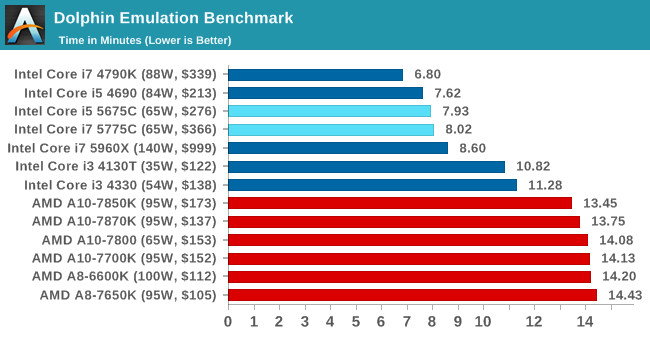
Crystal Well doesn’t help much in Dolphin, indicating it is more CPU frequency limited than DRAM/cache limited.
WinRAR 5.0.1: link
Our WinRAR test from 2013 is updated to the latest version of WinRAR at the start of 2014. We compress a set of 2867 files across 320 folders totaling 1.52 GB in size – 95% of these files are small typical website files, and the rest (90% of the size) are small 30 second 720p videos.
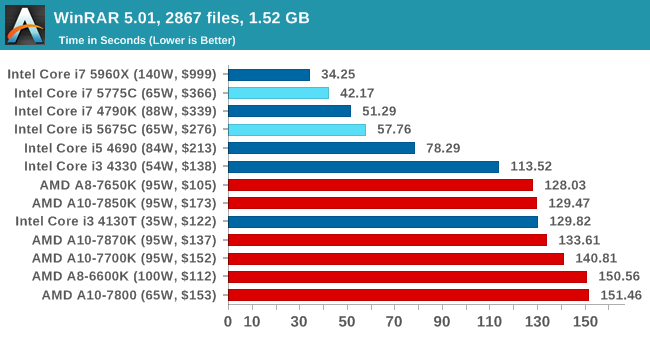
WinRAR is our typical benchmark to go to when testing whether DRAM is factor, and the improvements provided by the Crystal Well implementation trump any frequency deficit.
3D Particle Movement
3DPM is a self-penned benchmark, taking basic 3D movement algorithms used in Brownian Motion simulations and testing them for speed. High floating point performance, MHz and IPC wins in the single thread version, whereas the multithread version has to handle the threads and loves more cores.
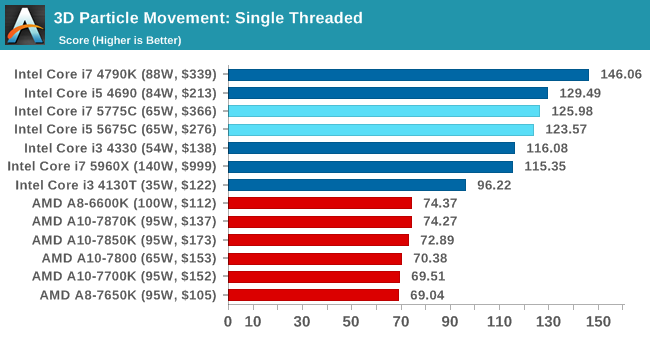
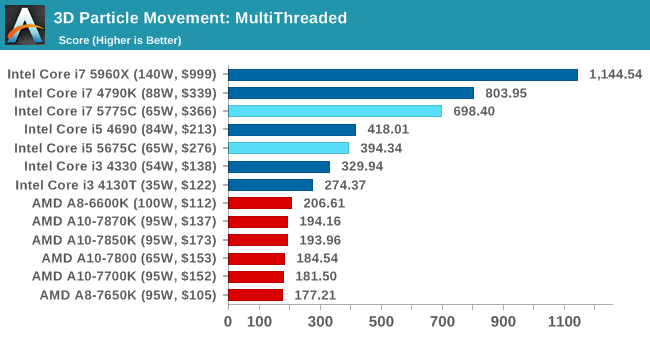
3DPM, like Dolphin, is concerned more with CPU frequency than DRAM accesses.
FastStone Image Viewer 4.9
FastStone is the program I use to perform quick or bulk actions on images, such as resizing, adjusting for color and cropping. In our test we take a series of 170 images in various sizes and formats and convert them all into 640x480 .gif files, maintaining the aspect ratio. FastStone does not use multithreading for this test, and results are given in seconds.
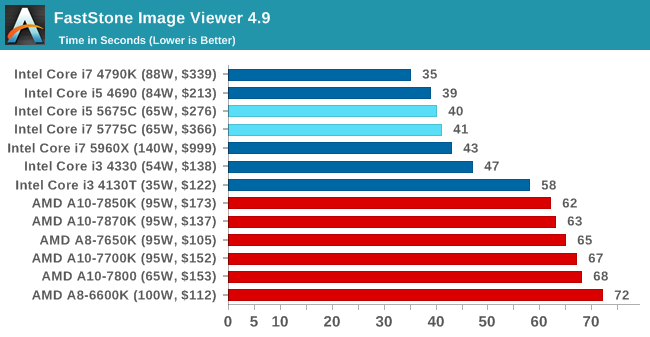
Web Benchmarks
On the lower end processors, general usability is a big factor of experience, especially as we move into the HTML5 era of web browsing. For our web benchmarks, we take four well known tests with Chrome 35 as a consistent browser.
Mozilla Kraken 1.1
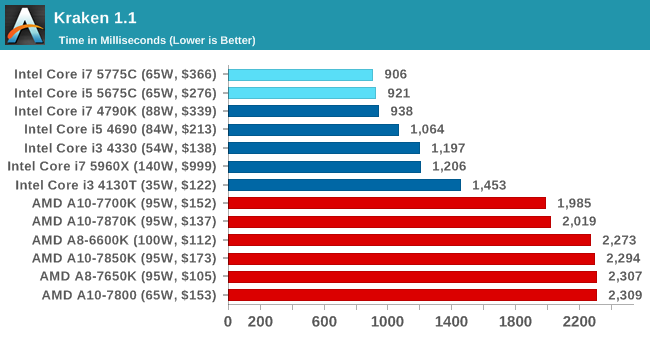
WebXPRT
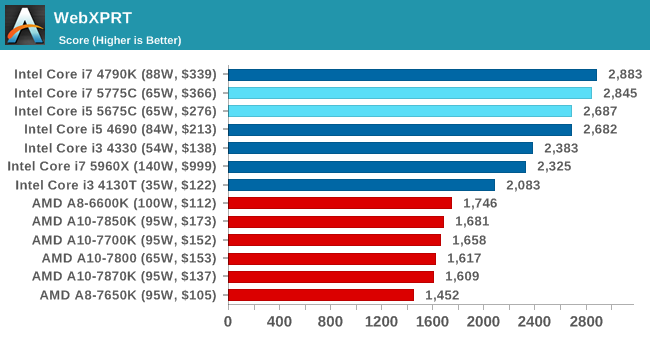
Google Octane v2

In the webtests, the Broadwell-DT CPUs didn’t necessarily take top spot but they are punching above their expected weight for their frequency.










196 Comments
View All Comments
extide - Tuesday, June 2, 2015 - link
Have you ever overclocked a CPU before? Those limits are easily raised, and a properly O/C'd build will not throttle...DCide - Tuesday, June 2, 2015 - link
It's hardly elite - just live video. But if the CPU saturates or crashes, everybody will know.I'm not skilled at overclocking. But for this application, stability is paramount. I wouldn't want to push it close to the limit, only to have it crash 5 hours into the stream. When I tested 4-core CPUs I had to run at low resolutions, or else the video would stutter. And I even at that I couldn't use all the features of the application.
With the same low-profile case and the same heatsink/fan the 4790K would throttle in less than 30 minutes while the 5820K and 5960X never would. They were all running at 4GHz. I'm sure someone more skilled could make all 3 CPUs run faster. But the 8-core is still going to be about twice as fast as the 4-core.
On the topic of the new CPUs, I won't be surprised if they O/C well enough to make them dominate the previous generations. But they won't be a match for the 2011-3 CPUs.
vision33r - Tuesday, June 2, 2015 - link
If you're into server workloads, 8 cores would nice. For gaming, more cores only adds more heat and hardly any benefit to gaming performance. For gaming, quad-core is good enough with no integrated GPU. All this integrated GPU stuff is just a waste of resources. Most of us into performance and gaming don't want the extra heat and power consumption.FlushedBubblyJock - Sunday, June 14, 2015 - link
If the kiddies can play WoW on it, amd and intel are happy. They will never stop.Galatian - Tuesday, June 2, 2015 - link
Would like to see some Quicksync Benchmarks! Anand noted fast Quicksync performance on the Iris Pro 5200, so I sure would like to see a) the differences between GT3e (Haswell) and GT3e (Broadwell) and b) the differences between GT2 (Haswell) and GT3e (Broadwell).Refuge - Tuesday, June 2, 2015 - link
I think that is coming in part 2 judging by the first two pages of the article.Kevin G - Tuesday, June 2, 2015 - link
I'll second the request for QuickSync testing. I do a bit of video editing with Vegas and do some bulk conversions with Handbrake so I have a keen interest on this topic.dj_aris - Tuesday, June 2, 2015 - link
I'd like to see the 65w 4770R in the charts to measure the delta over a a generation (okay half a generation). Meanwhile, considering that i5-5675C is $276 but games much worse than a Haswell Pentium + a decent $200 discrete card I really don't see the point in traditional desktops. The only scenario I see fit would be in a tiny case using a super low profile thin mini-ITX board, so as to create a system similar to, say, an Alienware Alpha. But wait, there aren't any thin mini-ITX H or Z97 boards. Whereas back with Haswell we had thin mini boards but only non-Iris iGPUs. Oh Intel, there's always a part missing!DCide - Tuesday, June 2, 2015 - link
I think you mean you don't see the point for a gaming desktop. A Pentium + $200 dGPU would be a poor choice for most traditional desktops.Mech0z - Tuesday, June 2, 2015 - link
With DX12 supporting multiGPU much much better, could it be theorized that these will be very good for DX12 games together with a dGPU?